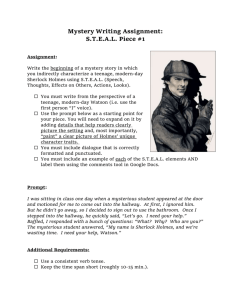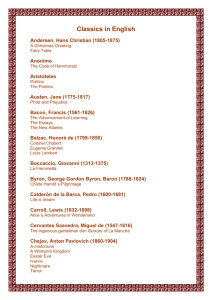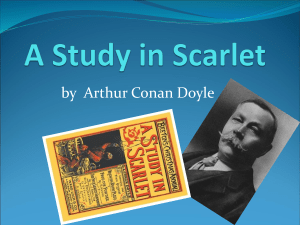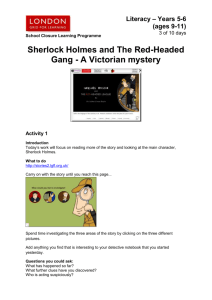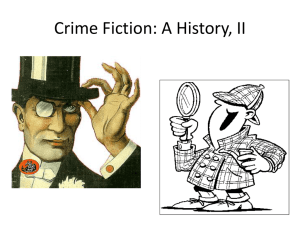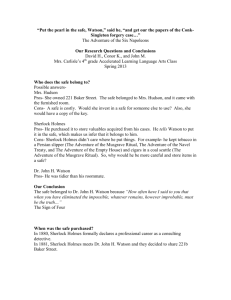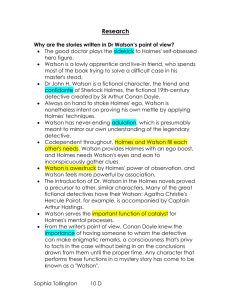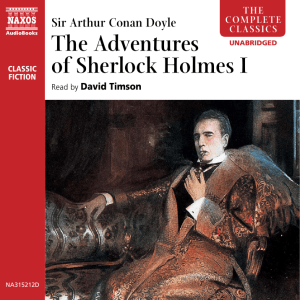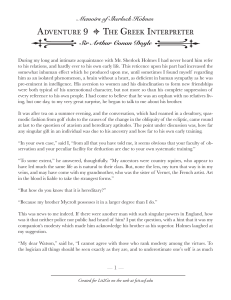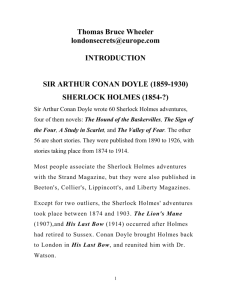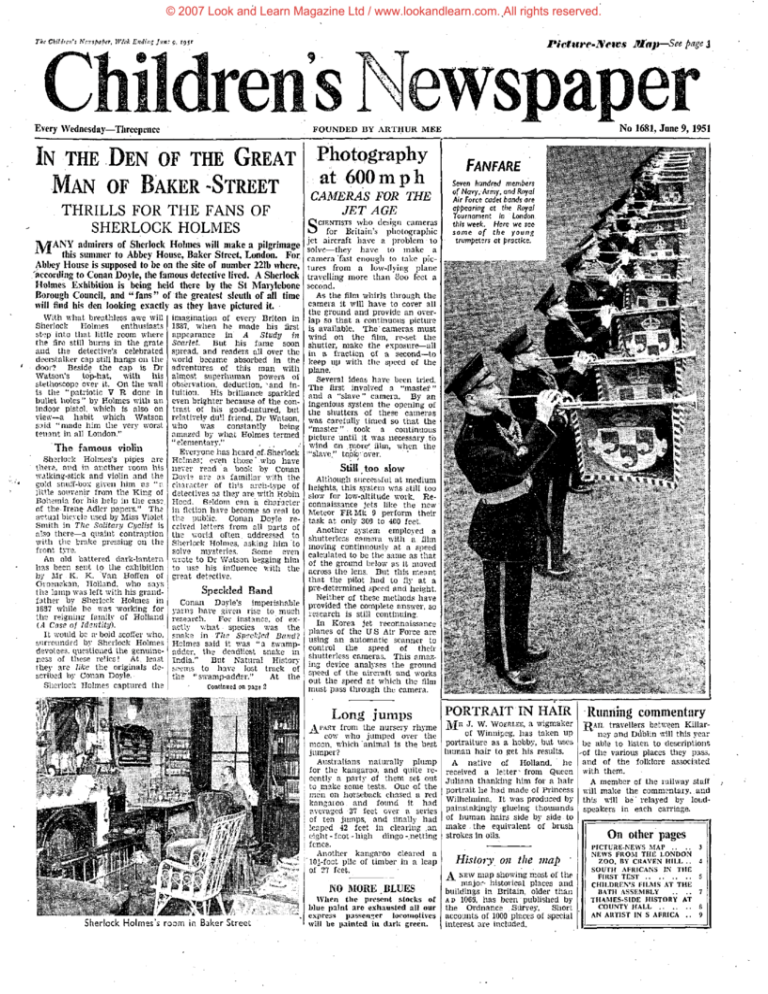
© 2007 Look and Learn Magazine Ltd / www.lookandlearn.com. All rights reserved.
The Children's Newspaper, Week Ending Jun: 9,
Picture-News
Every Wednesday—Threepence
THRILLS FOR THE FANS OF
SHERLOCK HOLMES
TV/TANY admirers of Sherlock Holmes will make a pilgrimage
this summer to Abbey House, Baker Street, London. For
Abbey House is supposed to be on the site of number 221b where,
according to Conan Doyle, the famous detective lived. A Sherlock
Holmes Exhibition is being held there by the St Marylebone
Borough Council, and "fans" of the greatest sleuth of all time
will find his den looking exactly as they have pictured it.
With what breathless awe will
Sherlock
Holmes
enthusiasts
step into that little room where
the fire still burns in the grate
and the detective's celebrated
deerstalker cap still hangs on the
door? Beside the cap is Dr
Watson's top-hat, with his
stethoscope over it. On the wall
is the "patriotic V R done in
bullet holes " by Holmes with an
indoor pistol, which is also on
view—a habit which Watson
snid "made him the very worst
tenant in all London."
The famous violin
Sherlock Holmes's pipes are
there, and in another room his
walking-stick and violin and the
gold snuff-bos given him as "a
little souvenir from the King of
Bohemia for his help in the caso
of the-Irene Adlcr papers." The
actual bicycle used by Miss Violet
Smith in The Solitary Cyclist is
also there—a quaint contraption
with the brake pressing on the
front tyre.
An old battered dark-lantern
has been sent to the exhibition
by Mr K. K. Van Hoffen of
Giosnekan, Holland, who says
th3 lamp was left with his grandfather by Sherlock Holmes in
1837 while he was working for
ths reigning family of Holland
(A Case of Identity).
It would be a- bold scoffer who,
surrounded by Sherlock Holmes
devotees, questioned the genuineness of these relics! At, least
they are like the originals described by Conan Doyle.
Sherlock Holmes captured the
No 1681, June 9, 1951
FOUNDED BY ARTHUR MEE
IN THE DEN OF THE GREAT
MAN OF BAKER-STREET
imagination of every Briton in
1887, when he made his first
appearance in A Study in
Scarlet.
But his fame soon
spread, and readers all over the
world became absorbed in the
adventures of this man with
almost superhuman powers of
observation, deduction, -and intuition. His brilliance sparkled
even brighter because of the contrast of his good-natured, but
relatively du'.l friend, Dr Watson,
who was constantly
being
amazed by what Holmes termed
"elementary."
,
Everyone has heard of. Sherlock
Holmes; even those' .who have
never read a book by Conan
Doyle are as familiar with the
character of this arch-type of
detectives as they are with Robin
Hoed. Seldom can a character
in fiction have become so real to
the public. Conan Doyle received letters from all parts of
the world often, addressed to
Sherlock Holmes, asking him to
solve mysteries.
Some even
wrote to Dr Watson begging him
to use his influence with the
great detective.
Speckled Band
Conan Doyle's imperishable
yarns have given rise to much
research. For instance, of exactly what species was the
snake in The Speckled Band?
Holmes said it was "a swampadder, the deadliest snake in
India." But Natural History
seems to have lost track of
the "swamp-adder."
At the
Continued on paje 2
Photography
at 600 m p h
CAMERAS FOR THE
JET AGE
who design cameras
SCIENTISTS
for Britain's photographic
jet aircraft have a problem to
solve—they have to make a
camera "fast enough to take pictures from a low-flying plane
travelling more than iioo feet a
second.
As the film whirls through the
camera it will have to cover all
the ground and provide an overlap so that a continuous picture
is available. The'cameras must
wind on the film, re-set the
shutter, make the exposure—ail
in a fraction of a second—to
keep up with the speed of the
plane.
Several ideas have been tried.
The first involved a "master"
and a "slave" camera. By an
ingenious system the opening of
the shutters of these cameras
was carefully timed so that the
"master" . took a continuous
picture until it was necessary to
wind on .more' film, when the
"slave" topkr'over.
FANFARE
Seven hundred members
of Navy, Army, and Royal
Air Force cadet bands are
appearing at the Royal
Tournament in London
this week. Here we see
some of the
young
trumpeters at practice.
Still too slow
Although successful at medium
heights, this system was still too
. slow for low-altitude work. Reconnaissance jets like the new
Meteor FR Mk 9 perform their
task at only 300 to 400 feet.
Another system employed a
shutterlecs camera with a film
moving continuously at a speed
calculated to be the same as that
of the ground below as it moved
across the lens. But this meant
that the pilot had to fly at a
pre-determined speed and height.
Neither of these methods have
provided the complete answer, so
research is still continuing.
In Korea jet reconnaissance
planes of the U S Air Force arc
using an automatic scanner to
control the speed of their
shutterless cameras. This amazing device analyses the ground
speed of the aircraft and works
out the speed at which the film
must pass through the camera.
Long jumps
^
from the nursery rhyme
cow who jumped over the
moon, which "animal is the best
jumper?
Australians naturally plump
for the kangaroo, and quite recently a party of them set out
to make some tests. One of the
men on horseback chased a red
kangaroo. and found it had
averaged 37 feet over a series
of ten jumps, and finally had
leaped 42 feet in clearing .an
eight - fcot - high dingo -.netting
fence.
Another kangaroo cleared a
lO'.-foot pile of timber in a leap
of"27 feet.
NO MORE.BLUES
Sherlock Holmes's room in Baker Street
Map—See page j
When the present stocks of
blue paint are exhausted all our
express passenger locomotives
will be painted in dark green.
PORTRAIT IN HAIR
Running commentary
]\/JK J. W. WOERLEE, a wigmaker
JJAIX travellers between Killarney and Dublin will this year
be able to listen to descriptions
-of the various places they pass,
and of the folklore associated
with them.
A member of the railway staff
will make the commentary,. and
this will be' relayed by loudspeakers in each carriage.
of Winnipeg, has taken up
portraiture as a hobby, but uses
human hair to get his results.
A native of Holland, he
received a letter" from Queen
Juliana thanking him for a hair
portrait he had made of Princess
Wilhelmina. It was produced by
painstakingly glueing thousands
of human hairs side by side to
make . the equivalent of brush
strokes in oils.
History on the map
J^ NEW map showing most of the
major- historical places and
buildings in Britain, older than
AD 106G, has been published by
the Ordnance . Survey. Short
accounts of 1000 places of special
interest are included.
On other pages
PICTURE-NEWS MAP . . . .
NEWS FROM THE LONDON
ZOO, BY CRAVEN HILL . .
SOUTH AFRICANS IN THE
FIRST TEST . . . . . .
..
CHILDREN'S FILMS AT THE
BATH ASSEMBLY
.. ..
THAMES-SIDE HISTORY AT
COUNTY HALL
AN ARTIST IN S AFRICA . .


